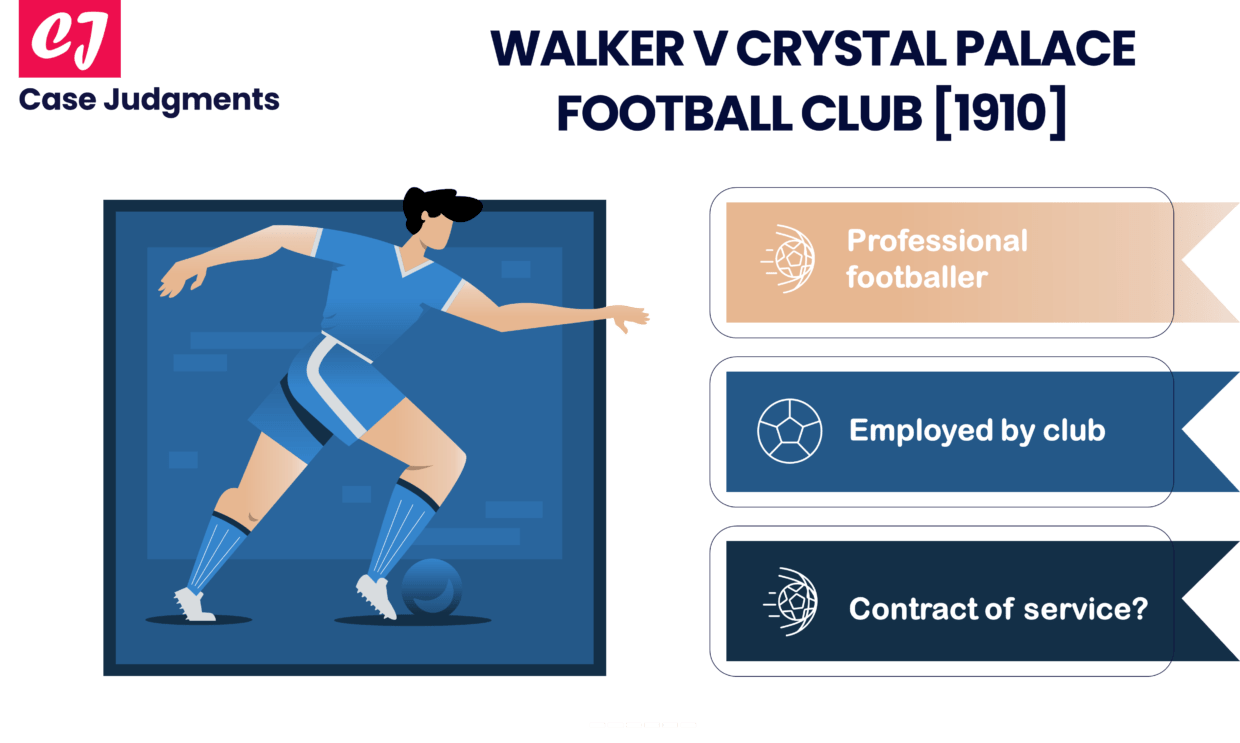
Walker v Crystal Palace Football Club [1910]: Case Summary
Case name & citation: Walker v Crystal Palace Football Club Ltd. [1910] 1 KB 87
Court and jurisdiction: The Court of Appeal, England and Wales
Year of the case: 1910
The bench of judges: Cozens-Hardy, M.R., Fletcher Moulton and Farwell L.JJ.
Area of law: Employment status under labour law
What is the case about?
This is a UK labour law case that addressed the employer-employee relationship and whether it constituted a contract of service.
Facts of the case (Walker v Crystal Palace)
A footballer worked in a club. The issue was whether or not he was considered to be employed by the club in order for him to be eligible to claim compensation under the Workmen’s Compensation Act 1906 as a result of an accident that occurred while participating in a match.
He was paid £3.50 per week for a year’s contract with the club and was expected to provide his playing services exclusively to the club. He was supervised by the club during training and was also expected to be available for matches.
Assertions by the club and arguments
It was argued that he was not covered by the Act. The club asserted that he did not have a contract of service because, according to its reasoning, it was necessary for there to be a master-servant relationship in which the master had the authority to direct how the work should be done.
For this, reliance was placed on the definition of an employee given by Bramwell J in Yewens v Noakes (1880). It said, “a servant is a person who is subject to the command of his master as to the manner in which he shall do his work”. Yewens v Noakes set out the historic ‘control test’ which said that there is an employer-employee relationship if an employer can not only tell the employee what to do but also how to do it.
It was argued that the definition given in Yewens v Noakes could not possibly be applied to professional football players because they are paid to display their skills and talents. The only thing under the club’s control is determining whether or not a particular player will be included on the team.
Judgment of the Court in Walker v Crystal Palace
Farwell J rejected this plea on the grounds that many workmen displayed their own initiative, much like football players, but were still bound by the directions of their master. In this instance, the player had agreed to adhere to detailed training instructions and to follow his captain’s directions on the field.
The Court of Appeal decided that it was sufficient that he was obliged to obey the general directions of the club even though it was obvious that he relied on his own judgment regarding how to play.
As a result, it was determined that the professional footballer had a contract of service with the club. He was therefore an employee.
Concluding it
The control test evolved through this case. It was immaterial that the club had no control over the exact manner in which the player played because it still had control in the form of training, discipline and methods of play.
Nevertheless, it may be difficult to apply this concept of control in many situations. That is why several other tests were developed by the courts over time to determine employment status.
List of references:
- https://www.learnwithunite.org/assets/Uploads/Employment-Law-Eighth-Edition-v2.pdf
- https://pure.manchester.ac.uk/ws/portalfiles/portal/110328548/FULL_TEXT.PDF
- https://www.studocu.com/en-gb/document/university-of-lincoln/employment-law/employment-law-i-revision-notes/1616588
You might also like:
More from labour law:

